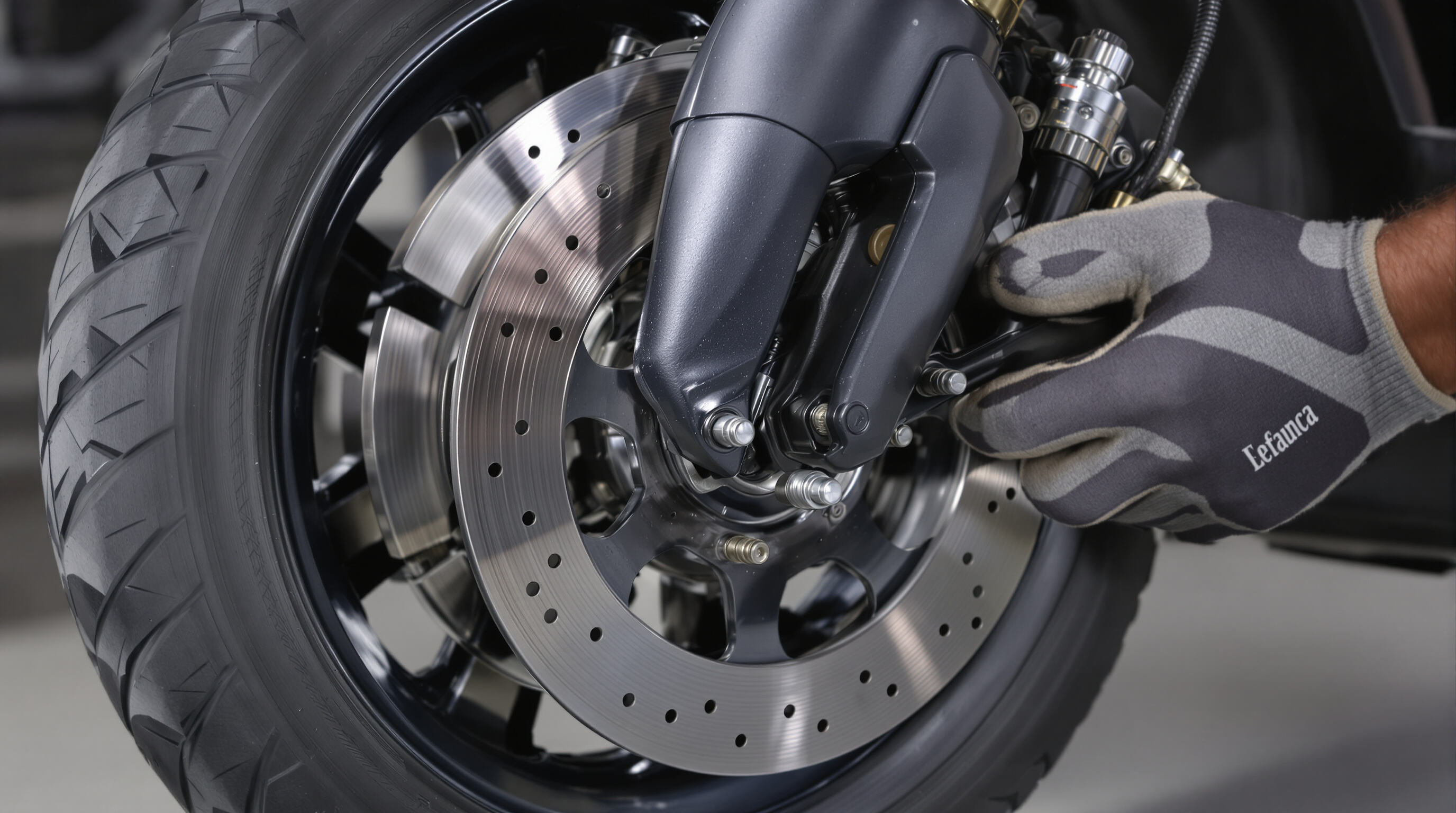
Disc brakes work by turning the energy of motion into heat through friction, which helps slow down HighMileage Delivery Scooters when needed. The process starts when someone pulls the brake lever, which sends hydraulic pressure to pistons inside the caliper assembly. These pistons then push the brake pads against a spinning metal rotor, creating just enough friction to stop or slow the scooter safely. Most riders will tell you that disc brakes are better than old style drum brakes for city deliveries because they handle heat much better. This really makes a difference in busy streets where delivery drivers need to stop constantly, sometimes going from around 15 to 20 miles per hour multiple times throughout their route without the brakes overheating or losing effectiveness.
Three core elements enable this braking action:
Bigger rotors measuring around 180 to 220 mm across give roughly 30 to 50 percent more stopping power compared to standard 140 mm discs because they offer more surface area for friction plus better leverage on the brakes. The vented design with those internal cooling channels cuts down heat accumulation by about 40% over solid discs, which means less brake fade even after multiple stops. This really matters when hauling heavy loads, say anything over 220 pounds, where overheating becomes a serious issue. And then there are those wave pattern rotors too. They actually help clear away road grime and water much faster, something drivers notice especially during morning deliveries when roads are still damp from overnight rain.

Dense city operations subject brakes to relentless stress. Congested routes require 10–15 times more daily braking cycles than rural routes, leading to continuous low-intensity heat accumulation. This causes pad oxidation, premature rotor wear, and accelerated brake fluid degradation, reducing hydraulic efficiency over time.
Moisture and contaminants accelerate breakdown: wet conditions increase stopping distances by 40%, demanding harder pad engagement. Road salts cause pitting corrosion on metal surfaces, while airborne particulates embed into pads as abrasives. High humidity promotes condensation, which can reduce pad friction coefficients by up to 15%.
Payload directly impacts brake workload—every 10kg over manufacturer limits increases stopping energy absorption by 5%. Cumulative wear intensifies with daily mileage:
| Mileage Band | Average Pad Replacement Frequency |
|---|---|
| <50km daily | 90–120 days |
| 50–80km daily | 60–75 days |
| >80km daily | 30–45 days |
| High-frequency braking and thermal stress lead to material fatigue beyond linear wear expectations. |
Delivery patterns involving near-continuous light braking cause more degradation than occasional hard stops. Constant moderate heat prevents proper cooling, creating sustained thermal stress that micro-fractures friction compounds—this is the dominant failure mode in urban food delivery fleets.
Monthly professional inspections are essential for high-mileage scooters in urban environments. Bi-weekly visual checks are advised during peak delivery seasons, especially in coastal or humid regions where salt and moisture accelerate corrosion, requiring evaluations 25% more frequently.
Measure pad thickness regularly with digital calipers. Replace organic pads below 1.5mm and semi-metallic pads below 2.0mm. Fleet data shows urban scooters carrying over 150lb loads typically need pad changes every 750 miles. Wear exceeding 0.01mm per 100 miles should prompt further investigation.
Watch for pulsating handlebars (indicating warped rotors), metallic grinding noises (exposed backing plates), and uneven pad deposits (suggesting caliper misalignment). Blue-tinted rotors signal overheating from dragging brakes. Fading braking power after repeated stops often precedes failure.
Most modern pads include audible wear indicators that emit a high-pitched squeal at approximately 1.8mm thickness. Industry standards (ISO 611) require immediate replacement when pad thickness reaches ¥1.0mm. Always measure rotor thickness with a micrometer and replace if below the manufacturer’s specified minimum.
Under urban operating conditions, brake pads on high-mileage delivery scooters typically last 3,000–5,000 miles. Wear rates vary by 40% depending on cargo weight distribution and braking intensity, with heavier loads accelerating wear by up to 32% in stop-and-go environments.
A 12-month study of urban fleets found Manhattan scooters required brake servicing 35% more frequently than suburban counterparts. Constant traffic signals and rough pavement led to replacement cycles as short as 2,800 miles, highlighting the importance of route-specific maintenance planning.
Brake systems in humid coastal regions experience 25% faster wear due to salt-induced corrosion. Fleet managers in Southeast Asia report component replacements every 2,400–3,200 miles, compared to 4,000-mile averages in Mediterranean climates (Global Fleet Operations Report 2023).
Telematics systems now enable dynamic maintenance scheduling by analyzing real-time brake temperature and deceleration forces. Advanced models predict pad wear within 200 miles by monitoring 15 operational parameters, helping fleets reduce unplanned maintenance by 61% through timely interventions.
Proactive maintenance significantly extends brake life and prevents failures in high-mileage delivery scooters. Following optimized procedures enhances safety while reducing downtime and costs.
Regular cleaning helps stop grit from building up, which speeds up wear over time. Grab some lint free cloths and go for non residue, plastic safe stuff like rubbing alcohol when wiping down parts. When working on rotors, always wipe them outwards from middle to outer edges instead of going back and forth - this keeps dirt from getting spread around everywhere. Don't ever point sprays at electrical bits since moisture plus electricity equals trouble waiting to happen. Studies show dirty friction surfaces actually cut braking power anywhere between thirty to fifty percent, so keeping things clean isn't just good maintenance, it's safety critical stuff too.
Apply solvent to cloths first, then target high-contamination areas: caliper slide pins, piston boots, and rotor vanes. Use soft-bristle brushes for stubborn debris—never metal tools. Rinse with low-pressure water within 60 seconds to prevent pooling, then air-dry completely before reassembly to avoid water-induced corrosion.
Follow these replacement guidelines:
| Component | Failure Sign | Action Threshold |
|---|---|---|
| Brake Pads | Thickness reduction | Below 1.5mm friction material |
| Contamination | Oil/grease saturation | |
| Rotors | Warping (runout) | Over 0.15mm lateral deviation |
| Scoring depth | Deeper than 0.5mm grooves | |
| Thickness loss | Below manufacturer minimum |
Scooters meeting these thresholds experience 15–25% longer stopping distances, according to urban safety assessments.
Scheduled replacement reduces maintenance costs by 40–60% compared to emergency repairs. Reactive approaches risk cascading failures—worn pads can damage rotors, quadrupling total repair costs. Proactive servicing prevents critical failures during high-demand delivery periods, ensuring reliability and safety.
Professional inspections should be performed monthly in urban environments. Bi-weekly visual checks are recommended during peak delivery seasons and in coastal or humid regions where corrosion accelerates.
Signs include pulsating handlebars, metallic grinding noises, uneven pad deposits, blue-tinted rotors, and fading braking power after repeated stops.
Wet conditions increase stopping distances, road salts cause corrosion, and high humidity can reduce pad friction. Telematics can help monitor these factors for proactive maintenance.
 Hot News
Hot News
© Copyright 2024 Shenzhen New Image technology Co., Ltd All Rights Reserved Privacy policy